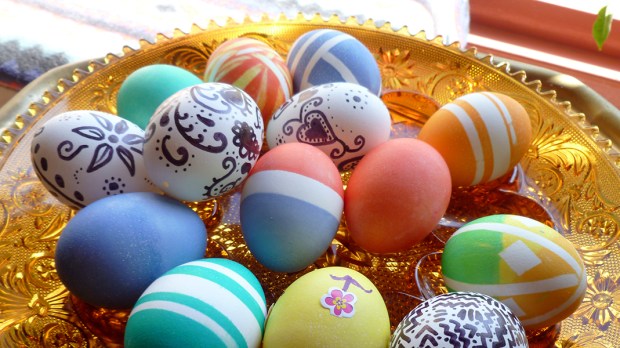The egg is ever-present in both the Jewish Passover and Christian Easter traditions. As the two holidays have such obvious connections, it is natural to consider whether this relationship extends to their use of the egg as a symbol.
In the Jewish tradition of Passover, a hard-boiled (or roasted) egg has a reserved spot on the Seder plate. The egg, representative of the Jewish Temple in Jerusalem, is dipped in salt water before eaten, this symbolizes the sorrow over the destruction of the Temple by the Romans.
The Christian tradition, however, sees the egg drained of its liquid innards and decorated with pretty colors. Often, instead of draining a raw egg, Christians will hard-boil them before painting, so that they can still be consumed.
While both religions have adopted the egg into their traditions, the disparity in their function creates more questions than it answers. Perhaps instead of focusing on the symbolism, it is more prudent to examine the history behind these practices.
Elon Gilad from Haaretz did just that and found the earliest reference to actually eating eggs during the Passover Seder comes from commentary written by the 16th-century Rabbi Moses Isserles. In his code of Jewish law called “Shulchan Aruch,” Rabbi Isserles wrote: “In some places it is the custom to eat as part of the meal, eggs.”
Rabbi Isserles offered no further explanation as to how the custom arose and we are left to assume it is either symbolic of the Temple’s destruction, or perhaps even of the Paschal Sacrifice, which was discontinued after the Temple was destroyed in A.D. 70. Either way, the presence of the egg at Passover seems to be in a reflective or commemorative function.
That the Rabbi mentioned “eating” the egg at all suggests that this was a custom he was unfamiliar with. From this we can infer that the tradition existed in Central Europe during the 16th century, and possibly spread from there. However, the egg was present on the Passover table for centuries prior to Rabbi Isserles, only it wasn’t there to be eaten.
Gilad explains that there has been much Rabbinic debate over the amount of matzoh and bitter herb should be eaten at Seder. In the Passover tradition, the bitter herb is representative of the harshness of slavery and the matzoh of the hasty flight from Egypt, which did not afford the Jews time to let their dough rise. The standard answer is “kaza’it” — the amount equivalent to an olive.
While this seems a good enough answer, Rabbis have argued the amounts, often using an egg as a reference. So rather than as food, the egg was a glorified measuring cup. Gilad writes:
Maimonides (1135-1204) said the amount of mandatory matzoh and bitter herb was just over a third of an egg. Rabbi Shlomo ben Aderet (1235-1210) said the amount should be a quarter of an egg’s volume. Rabbi Joseph Karo (1488-1575) advocated for half an egg.
From a Christian perspective, the earliest records of decorated Easter eggs come from 15th-century Germany. It is believed that the custom came to Germany from the farther eastern Slavic countries, but there are no written examples or artistic depictions to support this theory.
Gilad offers three factors that support the Slavic origins of Easter eggs: there is little evidence of the practice in the Middle Ages; the custom of coloring eggs is presently prevalent throughout Slavic lands, suggesting this is a time-honored tradition and not adopted; and it is a popular custom among the Syriac Orthodox Church, Syriac Maronite Church and the Armenian Apostolic Church, which severed ties with the Eastern Orthodox Church in the 5th and 6th centuries.
The evidence from Orthodox Christianity suggests the custom may have originated in Mesopotamia, with the Zoroastrians. At the Zoroastrian New Year (Nowruz, also the Iranian and Persian New Year), the faithful decorate eggs and place them on the table.
It is worth noting that the Zoroastrian Nowruz did influence the Seder, in the plate of symbolic foods set in the middle of the table. While Gilad could not outright reject the possibility of the origin of the Passover egg being Mesopotamian, he believes it is unlikely
A somewhat more likely explanation of the Easter egg comes from the Christian tradition of abstaining from eggs during Lent. Hens do not stop laying the eggs during the 40-day fast, but as the faithful could not eat them, they found another way to utilize the resource, lest it rot. Someone may have decided their uneaten breakfast could make a good decoration and soon all the eggs were dressed up in fun colors.
It is unlikely that the Jews got the egg from Christians. Even though the Christians were decorating eggs for Easter for a century before the Jews consumed eggs at Passover, the egg had previously been present as a tool for measurement.
With thousands of years of history behind these customs, we may never know the origins of either with any certainty. In the end Gilad concluded that connections are possible, but not probable.

